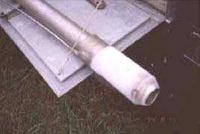|

|
The sample-freezing
drive shoe of the core barrel is in the foreground. A liquid carbon
dioxide (CO2) tank is in the background (CO2
is used to freeze the core). This photo was taken at the Cape
Cod Toxics Site. Click
here for a bigger version of the photo. |
|

|
Closeup of sample-freezing
drive shoe after retrieval from borehole. The photo shows ice
accumulated on the outside of the jacket as a result of the liquid
CO2 pumped down into the drive shoe while in the borehole.
This photo was taken at the Cape
Cod Toxics Site. Click
here for a bigger version of the photo. |
|

|
Field crew at the Cape Cod Toxics
Site working to cap the bottom of the core liner after a successful
coring attempt (sometimes the freezing is so successful that they
have a hard time getting the drive shoe off the end of the core).
Fred Murphy is in blue with
his back to the camera. Click
here for a bigger version of the photo. |
|

|
Closeup of sample-freezing
drive shoe after retrieval from borehole, and the core (in a polycarbonate
plastic liner) removed from the barrel. You can see the frozen section
at the bottom of the core.This photo was taken at the Cape
Cod Toxics Site. Click
here for a bigger version of the photo. |
|
|
Cutting a frozen core, Bemidji site. |
|

|
Successful core recovery using a core barrel modified with the sample-freezing
drive shoe. Tim McCobb (a hydrologist with the Massachusetts
and Rhode Island District) is 6'2" tall, giving you a sense
of the recovery on this core (about 7' for an 8' drive; not bad!).This
photo was taken at the Cape Cod
Toxics Site. Click here
for a bigger version of the photo. |
 |
Drilling at the Bemidji
Toxics Site using a prototype of the sample-freezing
drive shoe during the summer of 1990. Bill
Herkelrath is standing near the back of an open pickup truck to
the left, and Fred Murphy,
Don Boyce, and an assistant (from left to right) are operating the
drill rig. Click here for
a bigger version of the photo. |
 |
Fred Murphy with a soil core
collected with a prototype of the sample-freezing
drive shoe during the summer of 1990. Fred is removing the core
from a cryogenics chamber at the Bemidji
Toxics Site. The core is frozen to preserve the distribution of
fluids in the core for later chemical analysis. Click
here for a bigger version of the photo. |
 |
Isabelle Cozzarelli, a USGS organic geochemist based in Reston,
Virginia, and George Aiken, a USGS organic chemist based in Boulder,
Colorado, are taking water samples with syringes from core of aquifer
material from the Bemidji Toxics
Site that was just collected using the sample-freezing
drive shoe. The core is encased in a plastic tube. Small holes
are drilled in the tube, the syringes are placed in the hole, and
a small amount of water is withdrawn. A tank of nitrogen gas is used
to place a small amount of pressure in the tube to make withdrawing
water from the core easier. This technique allows Isabelle and George
to collect undisturbed ground-water samples at closely spaced intervals.
The chemistry of contaminant plumes can change drastically over short
distances, and this technique allows our scientists to study these
important changes that control the fate of contaminants. Click
here for a bigger version of the photo. |
 |
Closeup of a core barrel with the sample-freezing
drive shoe attached after injecting carbon dioxide into the shoe
at the Management Systems Evaluation
Area near Princeton, Minnesota, August 1994. The shoe is frozen
in the photo. Click here for a
bigger version of the photo. |
 |
Matt Landon and Bart Biernat with the USGS's Minnesota
District Office are removing a soil core from a core barrel on
the back of a pickup truck at the Management
Systems Evaluation Area near Princeton, Minnesota, October 1990.
The core was collected using a prototype of the sample-freezing
drive shoe. Click here
for a bigger version of the photo. |